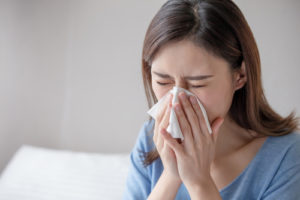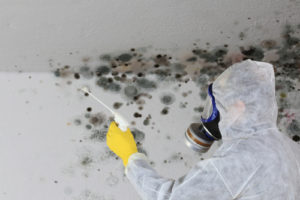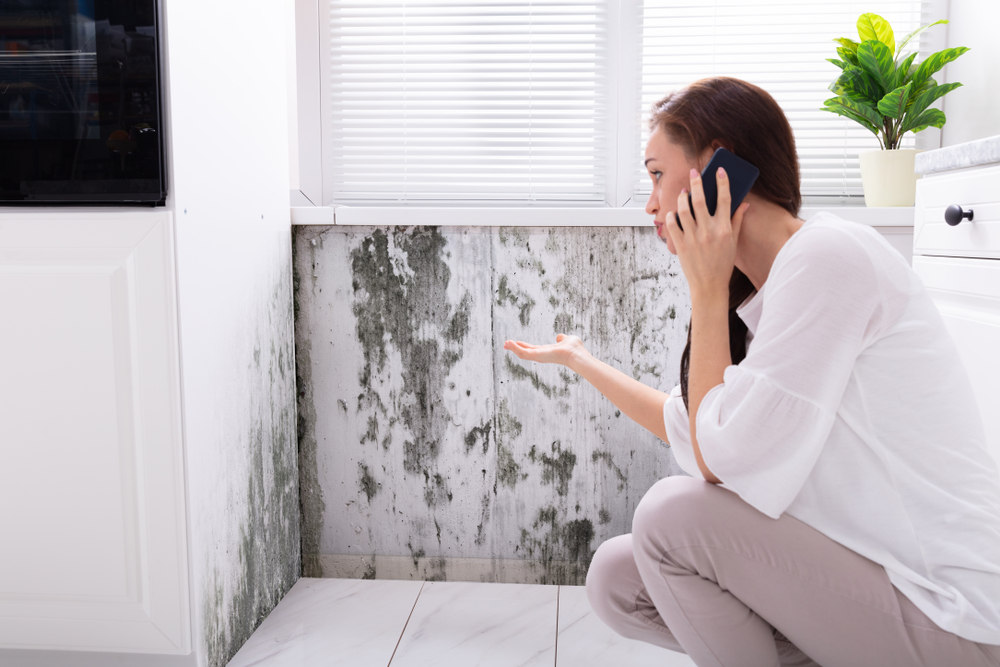Finding mold in your home is extremely stressful to any homeowner. Most of us find it not only gross but worrisome as well, given all of the health concerns we hear about in the news. Don’t worry quite yet if this happens to you, however. According to ABC News, although there are over “100,000 mold species”, only about “50 are considered toxic”.
So although it’s good to stay wary, don’t stress out just because you find a few flecks of mold in your home. Chances are, it’ll probably have little to no effect on your health if you get it cleaned as soon as possible. Hiring an expert to come to do a mold inspection and cleaning would be the fastest way to get rid of the problem and keep your family and home safe. Here at Austermiller roofing, we’re a one-stop shop for all of your mold-removing needs. We can do an inspection, remove the growth, and repair any damage it did to your home.
First, however, let’s go over some basics regarding mold and the effect that it can have on your health.
Mold In Home
Generally speaking, mold is a fungal growth that tends to spring up in moist areas. This means that leaky roofs, windows, and pipes are common culprits for mold growth.
This fungal growth, although not likely to kill you, can have some adverse health effects. In addition to this, mold can eat its way through organic materials such as paper and wood, making it dangerous to your home’s structure.
Having said that, as long as you get the mold removed promptly, it probably won’t get the chance to do too much damage.
Mildew VS Mold
Both mildew and mold are types of fungi, just with different characteristics and health risks.
Mold tends to be green, black, or red, while mildew is most commonly found in a shade of white or grey. Texture-wise they can also be distinguished by the fact that mildew is flat and powdery, while mold is fuzzy.
The most important difference between the two, however, is their effect on your health. Mildew can occasionally cause coughing and or make breathing difficult (especially if inhaled). Mold, however, can cause significantly worse health problems. In a nutshell, mildew tends to cause temporary or superficial health issues, but mold can have long-term effects.
Symptoms Of Mold Exposure

Keep in mind that people with allergies or chronic respiratory problems may be more at risk for symptoms of mold exposure, and not everyone shows symptoms upon contact with mold.
Although your exact symptoms depend on your body’s response, here are some common signs of mold exposure:
- Allergy symptoms – sneezing, coughing, runny nose, etc.
- Fungal infection symptoms – coughing, wheezing, difficulty breathing, and in worse cases, fever, chills, or even coughing up blood.
Unfortunately, these symptoms are fairly nondescript, so it may be hard to discern whether your sniffles are caused by actual mold or run-of-the-mill allergies. If you’re not sure what’s causing your symptoms, try distancing yourself from your house and see if you notice any difference in your symptoms. Do they get better when you’re at work and worse when you come home? Ask yourself questions like this. Another option is inspecting your house for mold.
Black Mold
Although black mold is often mentioned as the “scary” mold that may cause serious harm, little research can definitively support this. Most current research indicates that black mold has fairly similar effects as other types of mold. Having said that, there has not been enough research to confirm this with 100% certainty, so it’s best to remain cautious of black mold and get it removed as soon as possible.
Mold Inspection
Although we typically know mold when we see it, it may not always be visible. If you notice signs of water damage in your home, however, mold is likely to be close by. If anyone in your house experiences physical symptoms of mold exposure, that may also be an indication of mold growing in your home.
In these cases, it’s always best to get a professional inspection. Mold can be tricky to find, so hiring a water damage specialist would be your best bet. Additionally, it’s important to address the root cause of the mold. Since mold is often caused by moisture, you have to make sure to fix any leaks in the house to prevent any more mold from springing up.
Mold Removal
After finding mold in your home, it’s crucial to get rid of it. Aside from obvious health risks, mold can burrow deep and cause damage to your home. It’s especially dangerous to organic materials such as wooden beams. Mold can damage your flooring, ceilings, roof, and much more. It’s always best to call a specialist to do the removal to ensure that all of the spores are removed. Here at Austermiller Roofing, we can not only remove the mold but also repair any associated damage the fungus did to your roof, walls, or flooring.
Answers To Common Questions
Here are a few answers to common questions about mold:
How to test for mold?
Most of the time, mold can be identified with the naked eye. The best way to find out if your house has mold is to call a specialist to do an inspection. They will most likely check for dark spots, leaks, and moldy areas. Although you can also find out the exact type of mold by doing a laboratory test, this is usually not necessary.
How to clean mold?
The best way to get rid of mold is to call up a contractor. They can spray down the area with a mold-destroying solution and wash away the spores.
What does mold smell like?
Most people have described the smell of mold as “earthy” or “musty.” If you notice a strong damp smell in your home, it is possible that you have mold growing somewhere.
How to get rid of mold in the house?
Start by clearing out the immediate area (furniture, books, clothes, and any other nearby items). Then call a specialist to come do a mold removal treatment. They’ll spray down the area with a mold-killing solution and wash away the spores.
What causes mold in a house?
Generally, mold likes to grow in damp areas that have organic material for them to feed on. Two of the biggest culprits when it comes to mold growth are leaks and humidity. So if you’re running a humidifier, make sure not to overdo it.
What are the signs of mold in your house?
A consistent musty smell, dark stains/spots on your walls, dark streaks that grow in size, and moist areas.
How to check for mold in your house?
As we mentioned earlier, mold can usually be spotted visually. Look for fuzzy, green, or black areas. If the mold is hiding underneath wallpaper, it may be more difficult to spot, but dark water stains or leaks are a good indication. A good contractor should be able to identify the areas where the mold is growing.
How to prevent mold in the home?
Keep your house free of moisture (wipe down the shower, don’t overrun the humidifier, fix leaks asap, etc.). Also, keep air circulation in your house and make sure all of the vents are working properly.
Does home insurance cover mold?
The short answer is…it depends. Oftentimes, insurance policies will cover mold if it’s caused by an unexpected incident that’s not your fault. For example, if you’re covered for burst pipes and the damages caused by a burst pipe, it’s likely that your insurance will cover mold caused by the accident. Having said that, every insurance policy is different and has different requirements, so it’s always best to check with your insurance company.
Mold Removal In Tennessee

Looking for a qualified contractor to do a mold inspection or removal? Austermiller can lend a hand! We are a company of licensed professionals with over 25 years of experience under our belt. Not only that, but we care about our clients. We do our best to leave your property as clean and tidy as it was when we got there.
Proud to be serving the Tennessee area, simply give us a call or visit our website to schedule your mold inspection.

